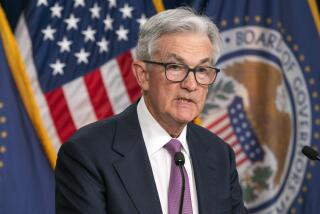No Fed Rate Boost Likely as Growth Slows
- Share via
NEW ORLEANS — The U.S. economy is growing slowly enough with inflation in check to keep the Federal Reserve Board from raising the federal funds rate on overnight bank loans any time soon, Fed Gov. Laurence Meyer suggested Sunday.
“We’re looking at measures of core inflation which are still declining,” Meyer said. “So while there may be some danger in the forecasts, it’s enough to keep us on alert, but not enough to take us off the sideline.”
After expanding at close to a 3% annual rate in the fourth quarter of 1996 that ended last Tuesday, growth should slow to a 2% to 2.5% rate this year and next, Meyer said at the American Economic Assn. conference in New Orleans.
Forecasts by Fed officials of 2.5% or slower growth that aren’t accompanied by inflation warnings are usually interpreted by analysts as a signal for keeping rates unchanged.
Unlike Meyer, Fed Gov. Lawrence Lindsey offered no 1997 growth forecast after his speech at the conference.
Instead, he said that as the new year begins, U.S. growth will probably remain moderate and inflation “will remain tame.”
Meyer said the current growth rate and low U.S. joblessness--at 5.4% in November--doesn’t point to faster inflation that might prompt an increase in the Fed’s target of 5.25% for the overnight bank lending rate.
Indeed, Meyer said, the U.S. economy is almost ideally positioned.
“Thirty-year low in terms of core inflation, [close to] a seven-year lows in terms of unemployment rate, declining deficits. What’s not to like?” he said.
Meyer said current risks are “much more evenly balanced” of the economy growing too fast, which could trigger higher inflation and a dose of Fed medicine in the form of higher rates, or slowing further, which could prompt the Fed to cut the overnight loan rate.
Meyer made the comments to reporters after he delivered a speech at the AEA about a newly redesigned macroeconomic model he said is helping the Fed set interest-rate policy by taking into account real-world factors such as the effect of changes in inflation expectations by bond investors.
The forecast presented by the Fed staff before the eight Federal Open Market Committee meetings each year will not change the federal funds rate, which is the benchmark for borrowing costs throughout the economy.
However, by using the Fed’s new FRB-US model and economic assumptions “roughly corresponding” to the policy options to be considered by the FOMC, members can see the potential impact of alternative policies on the Fed’s long-run objective of price stability.
More to Read
Inside the business of entertainment
The Wide Shot brings you news, analysis and insights on everything from streaming wars to production — and what it all means for the future.
You may occasionally receive promotional content from the Los Angeles Times.









